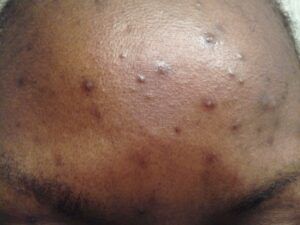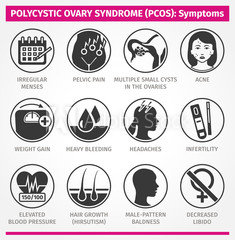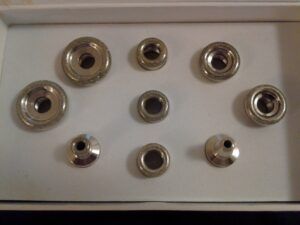This Article, “Chronic Acne | Hormone Imbalance… or Not” addresses some causes of acne, different manifestations, some triggers, and treatments in general.
Chronic acne may be a symptom of hormone imbalance… or maybe not. And, it can be very stressful for those it affects. Furthermore, adults, not just teenagers, suffer from this condition.
The first thing to do is find the root cause; therefore, start with a dermatologist to determine if hormones play a role.
Whatever the cause, you shouldn’t neglect acne of any type.

Does Chronic Acne Differ From Common Acne? | Let’s See.
A chronic condition means it is difficult to get rid of, keeps recurring, or lasting for a long time. Chronic acne, therefore, differs from common acne in that it is more of a nuisance.
Acne generally affects a person during puberty, although not everyone is affected in the same way. It ranges from mild to more severe, and may be hereditary.
Other factors and stages of life will also contribute to acne breakouts. Pregnancy and emotional stress are examples.
The sebaceous glands are responsible for oil production at the base of hair follicles. Some glands secrete directly through the pores of the skin, which are not attached to hair follicles.
In both cases of acne, the activities of sebaceous glands cause clogging of the pores. That also causes debris and grease on the surface of the skin.
Furthermore, external debris includes dirty hands, greasy hair/products and cosmetics. It also includes articles of clothing that come in contact with your skin.
Polycystic Ovary Syndrome | PCOS
Chronic acne is cause for concern. Learn about Polycystic Ovary Syndrome (PCOS) so you can be aware of all the symptoms associated with it. The chart below shows acne as one of the symptoms.

So you notice your acne constantly flairs up and wants to reside indefinitely. That’s a problem!
It’s common for acne to affect the face, but other areas include the upper arms, shoulders, chest, and back. For some people, it’s all areas at once.
The same treatment may be applied to all affected parts. And scars or black marks are sometimes left in place of the inflamed areas.
Chronic Acne | Let’s Take It From the Top.
Acne manifests itself in different forms. These may be…
Pimples or Acne Vulgaris:
An eruption takes place in the follicle when there is an excess of oil, dead cells, and bacteria. In the meantime, the body’s defense system, white blood cells, try to protect it against the bacteria.
This causes pus, a yellowish matter, to form. The farther this happens below the surface of the skin, the longer it takes to heal. Scars are usually the end result.
Whiteheads, Closed Comedones, or Milia:
These are an accumulation of matter from the sebaceous glands. They are trapped below the surface of the skin and are not exposed to air.
Blackheads or Open Comedones:
On the other hand, an overflow of oil from sebaceous glands results in the formation of a blackhead. It hardens at the mouth of the follicle causing blockage.
Chronic Acne | Let’s Look at Some More
Cysts or Cystic Acne:
These are pimples which take a longer time to reach the surface of the skin. Cells are destroyed while they make their journey up, leaving scars.
Papules:
Inflamed bumps under the surface of the skin indicate that there is infection in the hair follicles. And they can be painful.
Nodules:
If you have large painful bumps under the surface of the skin. They are a result of the activities at the lower level of hair follicles.
Apart from the physical symptoms of acne in general, some conditions are very painful.
In the Middle | Or No Middle Ground.
One way or another, your goal is to get rid of this abnormality. It may take more time than you expect, but make every effort to minimize it until then.
If your condition is caused by a hormonal imbalance, treatment will go beyond clearing up the physical appearance. Your dermatologist will have recommendations and, hopefully, point you in the right direction.
Some solutions are…
- Oral or topical antibiotics: These are prescribed to attack and destroy bacteria.
- Birth control pills/Oral Contraceptives: They help to control substances which contribute to causing acne.
- Laser and light therapy: These are both used to decrease oil production and kill bacteria that causes acne, respectively. They also help to diminish scars.
- Microdermabrasion and Chemical Peels: These help to diminish scars and are helpful with the overall texture and health of the skin. A dermatologist or licensed esthetician perform these services.

These are only some of the recommendations.
Note: As the PCOS chart in this article indicates, excessive hair growth is associated with the condition. In this case, laser hair removal (different from laser therapy used for treating acne) is one solution.
If hormonal imbalance is not a factor, you still need to take precautions. Practice proper hygiene to minimize any further outbreak, and apply appropriate treatment.
The Bottom Line Is… | You Need Your Life Back
You’re under the control of a condition that, more often than not, gets the better of you. What works for one person may not work for another.
It may take trying different products and treatments to find what works. It’s best, however, to give whatever you are trying time to work before moving on to something else.
Here are some other considerations that you can do on your own…
- Use hot and cold compresses to soothe the pain and decrease inflammation.
- Extractions are best done by an esthetician who is skilled in this area. Injuries to the surrounding tissue and scarring will not be an issue when carefully done.
- Witch hazel is soothing to the skin to alleviate redness and inflammation. It’s beneficial when applied after extractions to reduce redness.
- Use natural remedies with precautions just as with prescription or over-the-counter drugs. Tea tree essential oil is considered to be very helpful.
- Vitamins A and E, and zinc in the diet may be helpful.
- Drink plenty of water for hydration of the skin.
- Keep your hands off your face as this is one sure way to transfer bacteria.
- Avoid squeezing pimples, etc. as this will cause scarring.
- Never go to sleep with makeup on.
It is an excellent idea to have a regular skincare regimen including cleanser, toner or non-alcoholic based astringent, mask, some types of treatment, and a moisturizer compatible with your skin type.
A scrub can be a part of a skincare regimen; however, exfoliation may cause overstimulation of the sebaceous glands. This will worsen the condition.
I’ve seen cases where individuals kept scrubbing to get rid of acne, but their outbreak became worse. Discontinue the scrub and apply a mask twice weekly for significant improvement.
Overall, it’s harder for bacteria to thrive in a clean environment.
What to Avoid | Could It Be Your Favorite Food?
Take time to notice when flair ups occur. Is it around your monthly period, after eating certain foods, during stressful moments?
Chocolate was once considered a causing factor. Maybe it plays a role in aggravating an existing condition.
Here are some things to avoid…
- Greasy foods may worsen an existing condition.
- Spicy foods are considered to be stimulating to sweat glands.
- Stress usually seems to make any condition worse or result in the onset of several illnesses.

Not everyone agrees that foods play a part. You can experiment to see if it does, while taking all other factors into consideration.
Chronic Acne | Cleaning Up From Top to Bottom
So, here’s the thing: Chronic acne in any age group may be associated with Polycystic Ovary Syndrome (PCOS) due to hormone imbalance.
If you find you’re unable to control it, get medical help to determine the root cause.
A chronic condition stays around for a long time even with treatment. Acne, in general, is caused by overactivity in the sebaceous glands.
The secretions cause manifestations in different forms, which may be painful or leave scars. The areas most affected are the face, upper arms, shoulders, chest, and back.
A dermatologist specializes in skin conditions and should be consulted to determine the root cause and recommend a treatment plan.
Creams, pills, laser, and a skincare regimen are suggestions. These may help to ease discomfort, prevent bruises and scars, and decrease outbreaks.
Other helpful tips range from personal habits, home remedies, tea tree essential oil to professional skincare treatments by an esthetician.
We also looked at foods and habits to avoid. Most people will agree that although certain foods may not cause acne, they can aggravate the condition.
I hope this short article, “Chronic Acne | Hormone Imbalance or Not,” has helped you in some way.
There is a vast amount of information about the subject and related matter. This is just an introduction especially for those who are at a loss and need to be pointed in the right direction.
Feel free to leave your questions and comments below. I will do my best to address them.
Thank you very much for this valuable and detailed post about Chronic Acne. This is really a very important post. Because one of my friends is affected by something like this. I think he has no idea about this. And I didn’t know that fast food affects things like this. I will definitely share this post with him. Keep posting like this.
Hi Pasindu:
Thank you for taking the time to read and comment on my article. There are so many things that cause acne, and we have to pay attention to see how best to alleviate it.
I hope your friend finds value in the information here, and can take steps in helping his condition to clear up. I will continue to share.
Thank you.
Veron